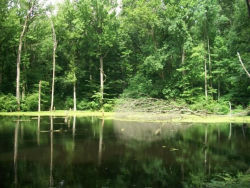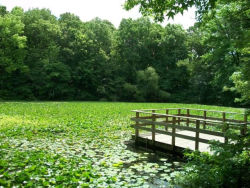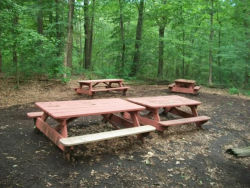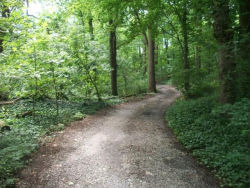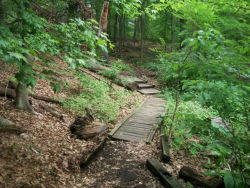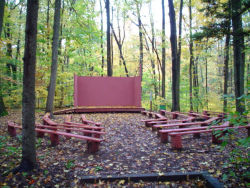High Rock Park
The Daily Plant : Monday, March 21, 2005
SPRING HIKES THROUGHOUT THE BOROUGHS
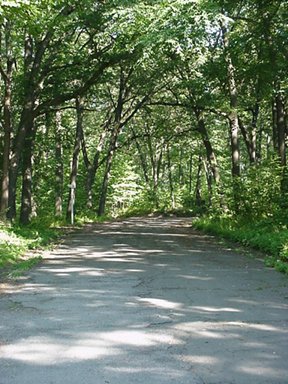
It's official--spring is here! Take advantage of the season's delights by exploring one of dozens of hiking trails across the City. Some of the City's best hikes are listed below, but for a complete overview of hikes in your neighborhood, call the Urban Park Rangers--they might even be hosting a guided hike near you. It's also a good idea to check with the Rangers to get an update on trail conditions, especially if the weather has been rainy. To find the Urban Park Ranger station closest to you, call 1-866-NYC-HAWK.
In the Bronx, a great spring hike is Van Cortlandt Park's John Muir Trail. Named for the famous naturalist, the trail is unusual because it runs on an east/west axis. Those looking for a strenuous, uphill hike should start on the western side, at Broadway and Mosholu Avenue, and head east. For an easy, downhill walk, hikers should start on the eastern side at Oneida Stree and Van Cortland East. The trail takes hikers past the Old Croton Aqueduct and the Mosholu Golf Course. There are plenty of animals to be seen, and the luckiest, quietest hikers may even catch a glimpse of the coyotes that live in the forests.
In Brooklyn, the Salt Marsh Nature Trail is especially beautiful this time of year. The trail lies at the westernmost inlet of Jamaica Bay in Marine Park, and begins at the Salt Marsh Nature center. About a mile long, the trail is a gravel path that follows the edge of the salt marsh, giving hikers glimpses of wetland wildlife. In the spring, red-winged blackbirds sing among the cattails, and Beach Plum, Henbit, and Purple Dead Nettle bloom. A bridge at the beginning of the trail offers hikers a place to look for fiddler and horseshoe crabs.
The upper reaches of Manhattan hold a lovely out-and-back hike that begins and ends at the Inwood Hill Nature Center. Beginning at the nature center, the trail winds around the salt marsh and the famous Shorakapok Rock, the site upon which--according to legend--the island of Manhattan was sold. It passes a Native American rock shelter, then cuts through one of the best bird-watching areas in the City. After hikers have had their fill of cardinals, titmice, and woodpeckers, the trail continues on to Overlook Meadow, which boasts a spectacular view of the Hudson River and the New Jersey Palisades.
A hike through Alley Pond Park in Queens will lead you around the "Kettle Ponds," which were formed 17,000 years ago by buried chunks of ice that melted and formed pools when the Wisconsin Glacier receded. The park lies on a glacier-formed ridge of sand and rock that marks the southern terminus of the Minnesota Ice Sheet. The ponds are host to freshwater and saltwater wetlands, tidal flats, meadows, and forest, creating a complex ecosystem that gives curious hikers a large variety of animal and plant life to observe.
To really get away from it all, hop on the Staten Island ferry and head to High Rock Park. Covering nearly 100 acres, High Rock contains five ponds and various wetlands, including Walker Pond and Loosestrife Swamp. Beginning hikers can wander at a leisurely pace through red maples, highbush blueberries, and skunk cabbage. More adventurous hikers can climb Mt. Moses, a 260-foot hill named for former Parks Commissioner Robert Moses. Because the trees are in bud, the overlook at the top of the mountain is panoramic this time of year, affording views of the Raritan Bay. Many of the trails in High Rock Park are connected, so ambitious hikers can walk for several hours through the woods, encountering few people and crossing only one or two roads. A variety of wildlife abounds on these trails: wood ducks, great blue herons, muskrats, hawks, owl, woodpeckers, frogs, and turtles.
QUOTATION FOR THE DAY
"I am a member of a team, and I rely on the team, I defer to it and sacrifice for it, because the team, not the individual, is the ultimate champion."
Mia Hamm
(born 1972)
Check out your park's Vital Signs
Clean & Safe
Green & Resilient
Empowered & Engaged Users
Share your feedback or learn more about how this park is part of a
Vital Park System

